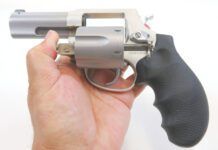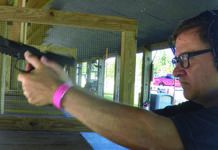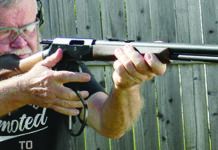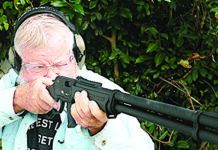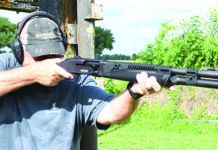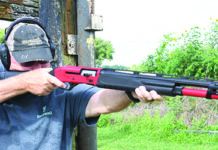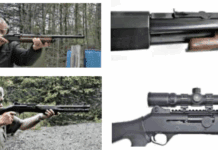New AR-15 shooters-and there are hundreds of thousands of them in the last five years-face a bewildering set of choices when they consider buying a new rifle. Chambering (whats the difference between 223 Rem. and 5.56 NATO, and can the rounds be shot interchangeably?), features (rails, grips, handles, sights), and even color (basic black, sand, olive drab, or multiple color tones) are among the decisions the new buyer must ponder. And, of course, theres price, and now, gas mechanisms. The appearance of gas-piston systems in ARs has been variously hailed as a game-changer and as nothing special. Gun Tests readers have been asking for tests of gas-piston system (GPS) guns, and we are nearing the completion of head-to-head tests of several of those guns. But is standard AR direct-impingement-gas (DIG) operation going by the wayside?
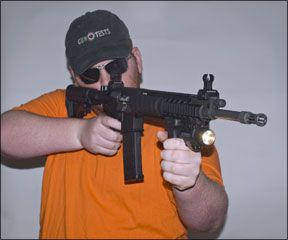
Perhaps, but we dont think so. There are many very good guns that work with the proven DIG system, and if GPS does supplant DIG, that sea change will be many years coming. But as for today, we wanted to find out if a GPS gun was worth hundreds of dollars more than two cheaper DIG guns at various price points. Our contestants were the High Standard HSA-15 Flat-Top Carbine No. HSTX6551, which lists for $920 and carries the dual-caliber designation of 5.56 NATO / 223 Rem. It is a direct-impingement unit like the Stag Arms Model 2T 5.56x45mm NATO, $1125. Pitted against these two traditional mechanisms is Rugers new SR-556FB 5.56x45mm NATO-223 Rem., a gas-piston gun that has an MSRP of $1995, but which commonly sells for around $1700. Thats a $575 premium above the Stag and a whopping $780 jump above the High Standard. But to see if those numbers reflect true value or simply fewer useful features, we had to get down in the weeds and shoot the guns side by side and see what we liked and what we didnt. But first, lets look at how the guns differ internally.
The Gas Systems
The operational system employed by the High Standard and Stag guns is known as direct gas impingement. This original AR-15 gas-impingement mechanism was developed by Gene Stoner more than a half-century ago. In this design, gas is tapped from the barrel as the bullet moves past a gas port located above the rifles front sight base. The gas rushes into the port and down a gas tube, located above the barrel, which runs from the front sight base into the AR-15s upper receiver. Here, the gas tube protrudes into a gas key (bolt carrier key), which funnels it into the bolt carrier. The bolt and bolt carrier together form a piston, which is caused to expand as the cavity in the bolt carrier fills with high-pressure gas. The bolt is locked into the barrel extension, so this expansion forces the bolt carrier backward in line with the stock of the rifle. As the bolt carrier moves toward the butt of the gun, the bolt cam pin, riding in a slot on the bolt carrier, forces the bolt to turn and unlock from the barrel extension. Once the bolt is fully unlocked, it begins its rearward movement along with the bolt carrier. The bolts rearward motion extracts the empty cartridge case from the chamber, and as soon as the neck of the case clears the barrel extension, the bolts spring-loaded ejector forces it out the ejection port in the side of the upper receiver.
This mechanism is battle-proven, and during this history, its been shown that when hot propellant gases vent into the bolt/chamber mechanism, heat and fouling problems can result. Enter the purported solution.
In the gas-piston system like that used in the Ruger, gases from the barrel vent into the gas block and then against a piston, which in turn strikes an operating rod that replaces the gas tube. Thats why gas-piston AR-15s are said to operate cooler and cleaner than gas-impingement systems. And in the case of the Ruger, if the companys gunbuilders indeed agree that the gas-piston system is better, it makes sense to create its new SR-556 using the better GPS design, rather than the original Stoner system.
If for the sake of argument we agree with Ruger that the piston systems are indeed cleaner and cooler, then we next must ask, “So what?” From a soldiers standpoint, in which reduced fouling and cooler operation could be lifesavers, its hard to argue against the GPS technology, assuming again that its superiority extends to an individual gun. But from a consumers standpoint, in which we must balance high-volume and high-speed functionality against startup cost-the waters become muddier. How much shell volume will the average AR-guy actually shoot at a time, and in total, without cleaning his rifle properly, or at all? If the answer is “a lot,” then saving a couple of hundred dollars for a cleaner system makes sense. If the answer is “not so much,” then many buyers will want to save the money.
The Chambering Choice
Along with the gas-system decision, the prospective AR-buyer must also choose a chamber dimension that makes the most sense. If, as in this test, we want to be able to shoot cheaper, easily procured ammunition that will function in nearly any AR, then we have to choose rifles with 5.56mm NATO chambers. Heres why:
The 223 Remington is the most widely-used centerfire rifle cartridge in the developed world. In its 5.56x45mm military form, it is the primary issue ammunition for the U.S. Military and NATO forces.
The 223 Remington began as the 222 Remington in the 1950s. When the US military was looking for a new high-speed small-caliber round to replace the 308 Winchester, Remington started with the 222 Remington, lengthening the case enough to boost powder capacity by about 20%. This occurred in 1958, and the round was dubbed the 222 Remington Magnum. The cartridge was not accepted by the military, but it was introduced commercially. In 1964, the 5.56x45mm, also based on a stretched 222 Rem. case (and very similar to the 222 Rem Magnum), was adopted along with the new M-16 rifle. As with the 222 Rem. Magnum, the new military case achieved enhanced velocity by increasing case capacity with a longer body section and shorter neck. This military modification of the 222 Rem. was originally called the 222 Special but was later renamed the 223 Remington. In military metric nomenclature, the round was called the 5.56x45mm.
Thus, the 5.56mm NATO and 223 Remington cartridges and chamberings are similar but not identical. Military cases are generally made from thicker brass than commercial cases; this reduces the powder capacity, and the NATO specification allows a higher chamber pressure. The 5.56mm NATO chambering, known as a NATO or mil-spec chamber, has a longer leade, which is the distance between the mouth of the cartridge and the point at which the rifling engages the bullet. The 223 Remington chambering has a shorter leade, and it is only required to be proof tested to the lower SAAMI chamber pressure.
Problems: Using 5.56mm NATO mil-spec cartridges (such as the M855) in a 223 Rem.-chambered rifle can lead to excessive wear and stress on the rifle and may even be unsafe, and SAAMI (Sporting Arms and Ammunition Manufacturers Institute) recommends against the practice. In our testing over the years, weve found that using commercial 223 Rem. cartridges in 5.56mm NATO-chambered rifles work reliably, and weve not seen accuracy problems we can attribute to firing the shorter-leade 223 Rem. in longer-leade 5.56mm-chambered guns. So, it makes sense to us to ensure that ARs we buy are chambered for 5.56mm rounds, which can shoot both 223 Rem. and NATO ammo safely, and not to buy 223-caliber-chamber guns for general use (target shooting is a different matter), because they cant always shoot 5.56mm ammo safely.
How We Tested
So, in this test of guns suitable for the entry-level buyer, we also sought out low-cost ammo from three easily accessible sources.
The Monarch ammunition we used is sold at Academy sporting-goods stores, which we bought for $5.99/20, or 30 cents a round before taxes. It is loaded by JSC Barnaul Machine-Tool Plant in Barnaul, Russia. The 223-stamped FMJ ammo with a Cyrillic-character headstamp has lacquered steel cases and non-corrosive Berdan primers. The website is www.ab.ru/~stanok.
Next, we bought Silver State Armory (SSA) 5.56mm full-metal-jacket ammo online from the company at www.ssarmory.com. At the time of this writing, the SSA10075-55FMJ stock number was listed for sale at $10.99/20, but that particular load was out of stock. Its brass was headstamped “R P” for Remington Peters, and per round it cost 55 cents.
The Federal Ammunition bulk pack was purchased at Wal-Mart for $39.97/100, or 40 cents a round. Its the same round as the companys 223B load (www.federalpremium.com), with a full-metal-jacket boattail bullet. The brass is headstamped with the “F C” initials, for Federal Cartridge.
We shot all three guns with the supplied iron sights (front and rear were supplied for the Ruger and Stag, front only for the High Standard), and attached a scope to the topside Picatinny rails. We also attached a variety of accessories to the rails to test how easy stuff went on and off the guns. This turned out to be a major area of evaluation that put one gun far behind the others.
For accuracy testing, we shot all three guns off a Bench Master rifle rest ($125 from Brownells), using 30-round magazines from the manufacturers (two 30-round polymer units for the Ruger, one 30-round steel magazine each for the Stag and High Standard), along with additional 30-round steel magazines from Brownells ($20). We used a variety of adhesive targets from Birchwood Casey, settling on the fluorescent-orange 2-inch Target Spot as the best choice to contain ten-shot strings during 100-yard accuracy testing. For the 100-yard accuracy tests we fitted an RWS 3-9×44 Night Pro Illuminated MilDot Reticle scope onto the guns rails with Weaver 30mm High Rings with quick-detach crosslock bases.
To test for malfunctions, we ran 10 different ammos through the guns in 10-round blocks using 10 different magazines, which, thankfully, turned out to be largely a waste of time. We had one stoppage with the High Standard using Remington/UMC L223R3 ammo in a surplus magazine-a failure to extract. And we had one failure to feed with the Ruger when it failed to pick up the first round in a Brownells magazine which we may not have seated properly. In both cases, the failure rate was 1%, and neither problem repeated.
So, we had a lot to look at in terms of overall fit and finish, accuracy, and utility. Heres what our testers found over three days of shooting:
Stag Arms Model 2T 5.56x45mm NATO, $1125
Stag Arms of New Britain, Connecticut, has been in the AR-15 business since 2003, but has supplied forged receivers and other parts to the industry for about 30 years. The company sells eight model lines of AR-style rifles, handily numbered 1 through 8. The Model 1 is an impingement action, has a standard forend (like the High Standard tested below), and sports a carry handle. It sells for $949. The Model 8L is a new (available Dec. 1, 2009) left-hand gas-piston unit with flip-up sights that sells for $1175. The Model 8 right-hand unit, $1145, was added to the Stag catalog in September 2009, so the company has been busy adding piston models to its AR lineup.
We have tested Stag guns in several configurations, including the 6.8 SPC 5L (January 2009, B+), the SA6L (June 2008, B+) and the 2TL (October 2007, D). The 2TL is the closest configuration to the 2T we tested here, so we were watching carefully to see if the same problems we had with the left-hand unit were repeated here. Recent concluded auctions on GunBroker.com show this model selling between $950 and $1150.
The Stag Arms rifle came with a plastic hard case, owners manual, one magazine (30-round capacity where legal), bumper sticker, and a Stag Arms T-shirt, which makes a nice wipedown rag. The compact Stag 2T carbine had a six-position telescoping buttstock, a hard-plastic pistol grip with one finger groove, integral Picatinny-compatible accessory rails on the forward handguard and on top of the receiver, a sling attachment loop at the toe of the buttstock, and two sling loops on the bottom and left side of the gas block. It had a standard A2-style protected front post sight, a bayonet lug, and a fold-down A.R.M.S. 40L rear sight with two apertures.
The Samson Star-C M4/M203 handguards measured 7 inches in length, thus presenting 28 inches of forward mounting surface for whatever geegaw you want to screw onto the gun. The handguards are free-floating, so adding accessories wont affect the point of impact. To ensure repeatability, the handguards had reference numbers on the top and bottom, handily marked with “T” and “B” and numbers in white letters. Adding another 12 inches of sight rails on top of the receiver brought the grand total of mounting surface to 40 inches. That seemed like enough, our team said. The top forend rail was in line with the rail that stretched across the top of the receiver.
The gun was supposed to come with protective covers for the handguards, but our sample lacked them. The company sells a 30-pack of three-slot rail covers for $15. But the Troy Industries 7-inch rail covers (SCOV-BRC-30FT-00, $35) on the Ruger fit the Stags rails perfectly, so we might order them instead.
The M-4 style 16-inch contoured barrel had a 1-in-9-inch twist, was chrome lined, and had a closed-bottom flash suppressor, bringing the tubes OAL to 17.25 inches. The gun itself had an OAL of 32.25 to 35.25 inches, depending on what length you set the stock (10.2 to 13.5 inches) for. It weighed 7.25 pounds unloaded and 8.3 pounds loaded with a Brownells 30-round magazine in place. The forged 7075-T6 anodized aluminum receiver with forward assist and brass deflector was fitted very well, with no discernable play between the upper and lower halves. After our test was complete, we noticed wear-through on the brass deflectors black finish.
There were two sling loops on the Stag Arms carbine. One was attached beneath the front sight and the other was clamped to the barrel within the confines of the front sight assembly. The choice of loops can make the carbine easier to carry, but when shooting, slinging up with either loop could have a negative effect on accuracy.
The Stag front sight was adjustable for elevation by depressing the detent and turning the post clockwise for a higher point of impact or counter clockwise to bring the shots down. The flip-up rear sight was adjustable for windage only and could be used full time or stowed in favor of an optical scope. The unit was seated by a cross pin that offered a clamp on the left side (engraved with a forward arrow for proper mounting) and a nut machined for a slotted screwdriver. When the nut was removed, it stayed with the unit thanks to being attached by a wire. The unit was held in its down position by a sprung lever. We found we could raise or lower the lever and put the sight in play with one hand.
Once the sight was upright, there were two apertures available to the shooter. The first aperture was the small peep sight that we used for our bench session. That aperture could be peeled back to reveal a larger one. Atop both apertures was a matching notch. This was a coarse setting that could be used in close quarters.
We began our live-fire tests from the 50-yard bench. Each shot was fired with a careful controlled press that showed the Stags heavy-ish 7.6-pound trigger pull was repeatable, but not match quality by any means. There was slop in the take up, which we eventually used like the first stage of a two-stage trigger.
Later, in the 100-yard bench section of the test, we used the accuracy measurement of Average Group Radius rather than shooting groups of three or five rounds and measuring their size. Reason: We wanted to shoot three 10-shot strings to delineate how barrel heating might affect bullet impact with these short tubes. To calculate AGR, we found the center of the 10-shot string and averaged the distances from the statistical group center to each shot. Using this system, each shot becomes its own data point, which increases the sample size, which improves the statistical significance of the data. Thus, AGR is a very good indicator of group size you can expect to get. We also reported Maximum Shot Radius, the distance from a groups statistical center to the center of the most distant hole-basically quantifying the worst shot in the string. Also, we noted each ammos Maximum Spread (group diameter) for the 10-shot strings. Thats simply the distance between the centers of the two widest shots in the group.
The Stag turned in the lowest (best) AGRs of the three test ammos, 0.76 inch with the steel-cased Monarchs and 0.74 inch with the Federals. It didnt much like the SSA 5.56mm ammo, shooting the worst AGR with that round, 1.26 inches. However, the difference with the Federal ammo was very small, since the Ruger shot 0.79-inch AGRs and the High Standard clocked in at 0.76 inches.
To test handling, we fired an action test in which the shooter brought the carbine up onto a near target, released the safety, and fired a shot at the first acceptable sight picture. It was during this portion of our tests that we realized that the Stag and the High Standard were much faster to the target than the Ruger. Our team said that was a combination of the lower overall weights of the two impingement guns, but also the Rugers weight distribution. The Rugers balance point was about an inch in front of the mag well (B17 on the bottom rail), making it more nose-heavy than the others, in the opinion of our team.
At this point, we really missed the Stags slip-on rail covers. The Ruger and the HS were much more comfortable to handle because of the Rugers rail covers and the HSs plastic forend.
We also came to prefer the Rugers Troy Industries Folding BattleSights to the Stags A.R.M.S rear unit and fixed front post. (The High Standard didnt come with a rear sight, so we swapped out the other two guns rear sights on the HS for this section of the test.) The HK-style Troy front sight has curved ears that protect the post and provide circle-in-circle visual shapes that were easier to center, our testers said.
Also, the flat-top design of the Ruger made it easier to install and use any optic we wanted without a specialized mount. The front-sight posts of the Stag and HS guns would block any lasers or red dots put on tops of the guns with just standard crossblock rings. A regular riflescope looked past the front post with no trouble, so the individual shooter will have to decide how to weigh this issue. For our testers, however, the Rugers flattop design gave it a big edge.
We also felt that the plastic pistol grips on the Stag and HS werent as comfortable as the Rugers Hogue rubber Monogrip. But all three units kept the standard trigger-guard dimensions, unlike replacement grips such as the Stark Equipment SE-1, which adds more room inside the trigger guard to accommodate gloves.
Our Team Said:We liked the Stag Arms Model 2Ts overall layout and light weight. It also shot extremely well with two of our test ammos. For many shooters, those are winning traits. But the Rugers flat sight-plane advantage was big for our testers. With that in mind, wed strongly consider a Stag Model 3 at $895 with a Picatinny-topped gas block and plastic forend, and the Troy sight package at $250. Or get the 2T with a Picatinny-top gas block instead of the front sight assembly. But that will drive the price up.
Ruger SR-556FB 5.56x45mm NATO
223 Rem., $1995
Ruger makes some well-known semiauto rifles, including the 10-22 22 LR and the Mini-14. But when the company rolled out the SR-556 in May 2009, it was the companys first foray into an increasingly crowded and competitive segment. And just looking at the feature set, including the two-stage piston-driven action, shows us the company put a lot of careful thought into the initial build.
To begin: The SR-556FB had a heavy contour, 16.12-inch chrome-lined barrel forged from Mil-Spec 41V45 chrome-moly-vanadium steel. The 0.700-inch-thick barrel had a 1:9 twist rate and was capped with an AC-556 flash suppressor. Our testers preferred the closed-bottom design of the other two guns hiders because theyre less likely to kick up debris if the shooter is on the ground. Chambered in 5.56mm NATO, the Ruger SR-556 also fired 223 Rem. ammunition, the wisdom of which we noted above.
The barrel and gas block were chrome lined, while the bolt, bolt carrier, and extractor were chrome plated. The piston-driven transfer rod was electroless nickel/Teflon coated. The flash hider and the exterior of the barrel, gas block, and regulator were manganese-phosphate coated. All aluminum parts were Mil-Spec hard-coat anodized.
The gun specs say the SR-556 comes with a one-piece 10-inch Troy Industries Quad Rail Handguard, but ours measured nearly 11 inches in length. Added to the Mil-Spec rail on top of the receiver, we counted almost 50 inches of rail surface to mount flashlights, lasers, grips, or perhaps a small barbecue pit. The handguard is pinned to the upper receiver and provides a mount for the piston-driven transfer rod. Three Troy rail covers provide a comfortable gripping surface.
On top, the SR-556FB is equipped with Troy Industries Folding BattleSights (thus the FB in the name), which our test team lauded above. They co-witness with Mil-Spec optics, and are easily removed or replaced. Pushing in a spring-loaded button on the right side of the sights allows them to be folded down or flipped up with one hand. The windage-adjustable rear sight includes two apertures, and the protected HK-style front sight is elevation adjustable.
At the butt is a six-position telescoping M4-style buttstock like we found on the other guns, but the Hogue Monogrip rubber pistol grip provides a better trigger-hand shooting surface than the other guns, our team thought.
Rugers published specs for the gun say it weighs “7 lbs. 15 oz.” without a magazine, but ours apparently was still carrying around turkey, and the scale dinged at 8.4 pounds without a magazine and 9.4 pounds with a loaded 30-round Magpul PMAG magazine in the maw. The gun came in a padded Ruger-branded carry case with hook-and-loop fasteners and internal magazine pockets. Ruger says the gun ships with three 30-round Magpul PMAGs, but our gun had only two. Even with two, the SR-556 still had an edge over the Stags and the High Standards one supplied magazines.
Of course, the heart of the gun is the patent-pending two-stage piston-driven operating system. Ruger claims it delivers a “smooth power delivery stroke to the action and vents combustion residue out of the bottom of the gas block.” The four-position adjustable gas regulator allows the operator to tune the rifle to specific ammunition and rifle conditions. In fact, at one point we dialed it down so that shells barely cleared the ejection port and we could more easily scoop up brass.
As a latecomer to the AR fray, it makes sense that Ruger skipped the DIG system and jumped to the piston system, at least in terms of current thinking. As you might guess, were skeptical about the superiority of the piston systems reliability, but we dont have data yet to back up that skepticism. Time and the market will shake that out. What we do know is that properly maintained DIG ARs are reliable because theres nearly half a century of data to back that up, and they are made by some well-thought-of companies, including Bushmaster, Remington, DPMS, Stag Arms, Smith & Wesson, Armalite, Lewis Machine & Tool, Colts,Knights Armament Co., and LaRue Tactical, to name a few.
Moreover, we recognize that the GPS choice likely creates tradeoffs in the SR-556 that consumers might not want. Something makes the Ruger heavier than the other guns in this test-perhaps some of it is the gas system, or the rails. But a pound is a lot-12% more than the Stag-and that weight sits forward. As a result, our shooters said the Stag and HS guns handled better.
The Ruger turned in the best performance with the SSA ammo (1.11 inch AGR), but it also had good results with the Federal FMJs, as we noted above. We also liked that it had smaller maximum spreads than the Stag. In our view, the guns 9.4-pound trigger certainly held back some of its accuracy potential.
But for the shooter who wants to include accessories in his kit, the Ruger easily beat the HS gun and, when optics were considered, it beat the Stag, too. The Troy rail system easily accommodated a riflescope, red dot, and laser. The Stag and HS guns could use a riflescope, but not the other optics because the front sight fixture blocked them. However, the Stag could use a laser on the side rails or bottoms, but not a red dot on top, unless we bought a special mount.
Our Team Said: One of the things that our testers worried about is whether the new SR-556 is completely debugged. In our tests, we had one early blip with the gun that didnt repeat, so this worry wasnt backed up by problems we can point to. Elsewhere, the Ruger is heavier and more expensive than the others, but it offers a heckuva lot of value that the DIG guns didnt. Our team would pick the SR-556 ahead of the High Standard gun by quite a lot-rails, sights, and supplied magazines were major benefits the Ruger enjoyed. The Stag vs. Ruger choice is a lot tougher. The Stag was lighter, but the Rugers rail system and sights were much better. The Stag was slightly more accurate with the Monarchs but slightly behind with the SSA ammo, and both it and the Ruger shot very well with the Federals, so with the right ammo, accuracy is a coin flip. So, well leave the choice like this: Both the Ruger and Stag guns get A- grades, and the shooter can decide for himself if he wants to pay more for the Rugers features. However, the test team judged the Stag as an Our Pick, and a lot of that decision was based on the price difference.
High Standard HSA-15 A4 M4 Flat-Top Carbine
No. HSTX6551 5.56 NATO-223 Rem., $920
High Standard Manufacturing based in Houston has long made and sold target pistols. Now the company produces four AR-15 variations that list for under $1000. The HSTX6500 and HSTX6550 are fixed-stock A2 units, with the HSTX6550 having a flat top with built-in Picatinny rail and 20-inch barrel. The HSTX6500 has a carry handle with A2 adjustable rear sight. The two collapsible buttstock units are the HSTX6501, with a carry handle with A2 adjustable rear sight and 16-inch barrel, and our test gun, the HSTX6551, a flat-top design with Picatinny rail and 16-inch barrel.
The HS rifle came in a cardboard shipping box with one magazine and no rear sight. The compact carbine had a six-position telescoping buttstock, a hard-plastic pistol grip checkered on the sides like the Stag, and one Picatinny-compatible accessory rail on the top of the receiver. It had a sling attachment loop on the bottom of the buttstock and one sling loop attached to the front-sight assembly. It had a standard A2-style protected front post sight and a bayonet lug.
Our team said the HSs ribbed plastic handguard was more comfortable to hold and manage than the railed handguards, with or without covers. The 16-inch chrome-lined barrel measured 0.729 inch thick and was marked for 5.56mm NATO rounds and a 1-in-7-inch twist, which differed from the manufacturers published twist rate of 1:9. The 1:7 twist will stabilize longer bullets better than the 1:9, so thats one advantage the HS has that we didnt test for. Like the Stag, the HS had a closed-bottom flash suppressor. The Ruger and the HS had a small amount of play between the upper and lower halves. Neither were as tightly fitted as the Stag, we thought.
The HSs main advantage was how easily it came up and steered. With a loaded 30-round magazine, the HS gun weighed just 7.5 pounds, and it showed great balance. On the downside, this weight traded off a fair amount of sight utility because the front of the HS just didnt offer many places to hang accessories. Also, at the minimum, youll have to add a rear sight of some sort for $100, or perhaps a detachable carry handle with back-up iron sights. (Brownells sells a DPMS unit for $90.) Also, the HS trigger was very heavy at 11.8 pounds, more than 4 pounds heavier than the Stags. It, too, had slop in the take up, but we found a way to make it work from the bench.
We got serviceable accuracy from the HS with all three ammos, shooting 0.76 inch with the Federals, 1.19 inches with the steel-cased Monarchs, and 1.24-inch average groups with the SSA 5.56mm ammo.
Our Team Said: The High Standard HSA-15 A4 M4 Flat-Top Carbine No. HSTX6551 5.56 NATO-223 Rem. will be the first pick of many shooters, even though it was our third choice. Its light weight and uncomplicated organization keep the best aspects of the M4 style-short barrel, collapsible stock, comfortable handguard-and add a flattop rail for easy riflescope mounting. These new High Standards are available exclusively through Lipseys Distributors, so have your dealer contact the distributor at (800) 666-1333 to order. Lipseys lists this gun at $950, and add a carry handle with sight and a couple of magazines, and youre looking at $1080 before FFL charges.



